Going Negative
August 30, 2010
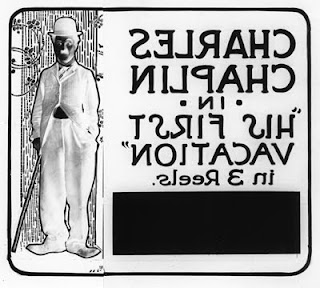
In DIY Coming Attractions I presented examples of hand-made slides that had been created by exhibitors to promote specific programs or venues. The procedures and examples described in the article focused on non-photographic techniques for applying text (and often color) to glass, such as writing, drawing, or etching. While such slides could use imaginative typography and line drawing to heighten interest and enhance visual appeal, they obviously lacked the ability to depict complex graphics, stills from the film, or most importantly, images of the stars.
Fortunately, exhibitors wishing to create their own slides were not limited to hand drawing or etching on glass. With a little effort they could also photographically create custom slides which presented several advantages.
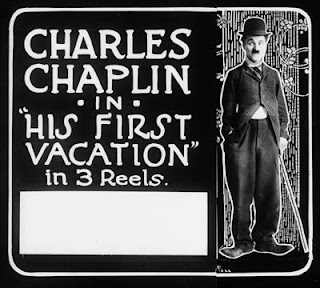
Photographically reproducing slides meant that multiple copies of the same slide could be created from a single negative. More importantly, photographic slides had the advantage that images of popular stars could be included in the advertisement.
In his 1915 manual, A Guide to Kinematography (Projection Section) for Managers, Manager Operators, and Operators of Kinema Theatres, Colin N. Bennett describes the process for printing slides in his section titled "Photographic Still Slides."
According to Bennett,
"For best results, hand-done originals should be drawn in liquid Indian ink on dead white paper."
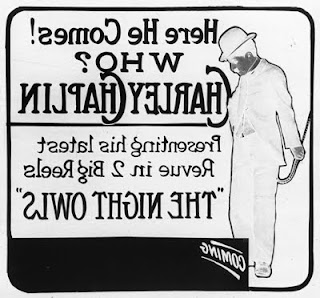
The original artwork is then photographed and the negative developed:
"Still view negatives are made by photography with a still view camera, either a snap-shot hand camera or a 'field' or 'studio' stand camera. The most convenient size of a plate to use for the negatives when making lantern slides by contact printing is 'quarter plate' or 4 ¼ by 3 ¼ in. Exposure, development, fixing, and washing are done on the same lines as laid down for kinematograph film, but the mechanical side of the work is simplified by there being only one single picture to develop instead of a long ribbon of different pictures."
From the resulting photographic negative, positive prints on glass are:
"...produced by printing off a photographic still view negative upon sensitive 'lantern plates.' obtainable at any chemist's or photographic dealer's shop. Those readers who have an acquaintance with kinematograph camera work will already have a clear idea of the operations involved in making a negative, and also in printing a positive transparency from it."
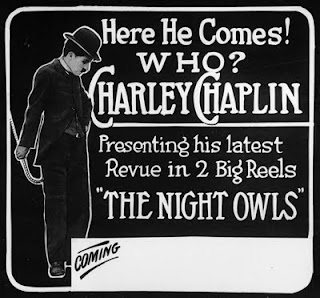
The photographic emulsion on the pre-coated lantern slide plates is exposed using a contact printing technique:
"To make the actual lantern slide from the negative, place a sensitive lantern plate, emulsion to emulsion, against the negative in a photographic printing frame and expose to artificial 'white' light [...]"
Finally:
"Fix, wash, and dry and [...] bind up the plate with a clear-glass cover-slip, interposing between the two a black paper mask to give neat edges to the slide on the screen. See that both plate and mask are bone dry before binding them together, and store completed slides in a bone dry, baize-lined, airtight box. If so kept they will not darken or 'sweat' during projection."
Recently while researching the slides held at the Margaret Herrick Library, I was thrilled to find a small number of these hand-made negatives within their collection. The three examples I've used to illustrate this article reinforce the notion that hand-made photographic slides were important in capitalizing on the drawing power of popular stars since they all feature the greatest star of the silent era.
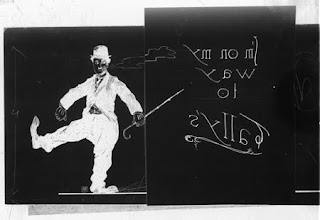
These slides for The Night Owls and His First Vacation are particularly interesting because neither of them are studio-released Charlie Chaplin titles. To capitalize on Chaplin's immense popularity, it was not uncommon for exhibitors to re-title older releases and pawn them off as new, or to combine footage from several prints in order to create a "new" film. Evidently this is the case with both of these titles, which may provide another explanation for why these are hand-made instead of professionally produced slides.
Having only the title as evidence, perhaps The Night Owls is a retitled release of the two-reel Essanay release A Night Out (1915) in which Chaplin and Ben Turpin wreak drunken havoc at a restaurant and later a hotel.
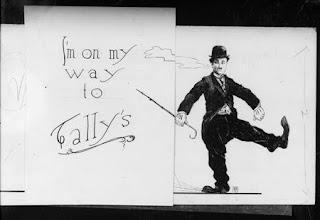
I'm at a complete loss when it comes to guessing patrimony of His First Vacation. My guess is that it is a pastiche of scenarios from several different films. My reasoning for this is that, with the exception of Tillie's Punctured Romance (1914) Chaplin never released a comedy as long as three reels until Shoulder Arms (1918) while I think it's safe to assume that His First Vacation is comprised of much earlier footage. In addition, a film about a "vacation" would provide an easy plot device that would explain stitching together episodes from several different comedies into a single narrative.
In either case, it may well be that these slides are the last remaining evidence of these ersatz Chaplin classics - unless someone out there turns up a print that is...
Slide images for this article courtesy of the Academy of Motion Picture Arts and Sciences.
